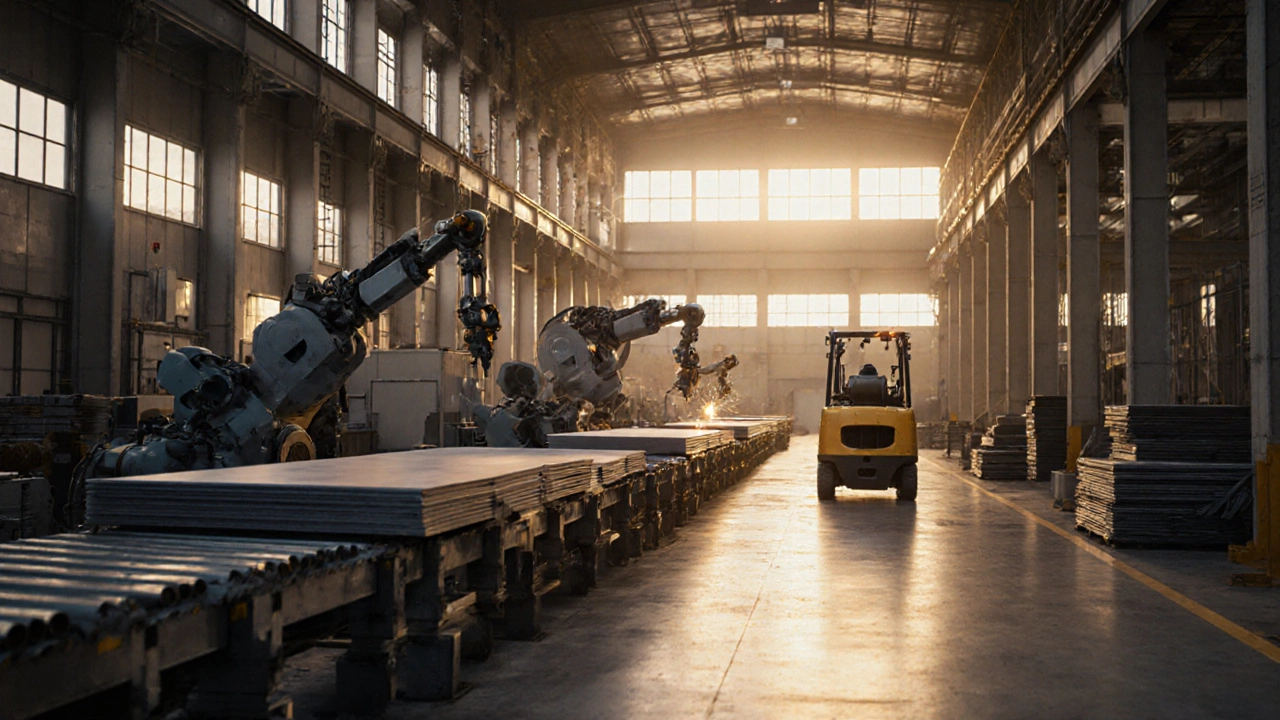What Are the 7 Flows of Manufacturing? A Clear Guide to How Things Get Made

When you think about how a car, a phone, or even a pair of sneakers gets made, it’s easy to imagine a line of workers assembling parts. But behind that visible process are seven invisible flows that make everything work - or break. These aren’t just steps in a manual. They’re the real heartbeat of manufacturing. If you’re running a factory, starting a small production line, or even just trying to understand why your order is late, knowing these seven flows changes everything.
Material Flow: The Physical Journey of Your Product
This is the most obvious one. Raw steel arrives. It’s cut, shaped, welded, painted. Then it moves to assembly. Finally, it’s packed and shipped. But material flow isn’t just about moving stuff. It’s about timing, layout, and waste. A poorly designed material flow means parts sit idle for hours, forklifts crash into each other, and inventory piles up in the wrong place. In lean manufacturing, this is called material flow. The goal? Keep it moving. Smooth. Fast. No bottlenecks. Factories that get this right reduce lead times by 30-50%. That’s not theory - it’s what Toyota did in the 1980s, and what modern factories still copy today.
Information Flow: The Hidden Backbone of Production
Every time a machine needs a new setting, or a quality check is triggered, or a supplier gets a new order, that’s information flowing. This flow is often invisible - emails, ERP alerts, barcode scans, dashboards. But if it breaks, the whole system stalls. Imagine a CNC machine waiting for a new program because the engineer forgot to send it. Or a warehouse shipping the wrong part because the system didn’t update. In 2025, most mid-sized manufacturers still use paper work orders or outdated spreadsheets. That’s a recipe for errors. The best factories use integrated digital systems that auto-update inventory, schedule maintenance, and notify suppliers in real time. Information flow isn’t IT - it’s production.
Energy Flow: Powering Every Machine, Every Minute
Factories don’t just use electricity. They use compressed air, steam, hydraulic pressure, and even waste heat. Energy flow is about where power goes, when it’s wasted, and how it’s managed. A single air leak in a pneumatic line can cost $5,000 a year in wasted electricity. In textile mills, inefficient steam systems can double fuel costs. Modern manufacturers track energy use per unit produced. Some install smart sensors on every major machine. Others use AI to predict peak demand and shift high-power tasks to off-peak hours. If your electricity bill keeps rising but output hasn’t, check your energy flow. It’s usually the hidden leak.

Financial Flow: Where the Money Moves
This isn’t about accounting reports. It’s about cash moving through the production cycle. Raw materials are bought. Labor is paid. Machines are maintained. Finished goods are sold. The speed and accuracy of this flow determine if you stay in business. Slow payments from customers? You can’t buy new parts. Overpaying suppliers? Your margins vanish. In small manufacturing businesses, financial flow is often disconnected from production. Someone orders 10,000 screws, but the sales team only booked 5,000 units. That mismatch kills cash flow. The fix? Link your production schedule directly to your invoicing and purchasing system. Real-time visibility turns financial flow from a headache into a tool.
Human Flow: Who Does What, When, and Where
People move between stations. They wait for tools. They get pulled into emergency fixes. They train new hires. Human flow is about movement, skill, and scheduling. A factory with poor human flow has workers standing around, doing nothing while machines run. Or worse - one person handles five different tasks because no one else knows how. High-performing plants map every worker’s path. They use cross-training so no one is a single point of failure. They schedule breaks so fatigue doesn’t cause mistakes. In Australia, many small manufacturers still rely on old-school shift boards. But the best ones now use digital dashboards that show who’s where, what they’re doing, and what’s next - reducing downtime by up to 25%.
Quality Flow: Catching Problems Before They Cost You
Quality isn’t just the final inspection. It’s built into every step. A misaligned part at station 3 becomes a defective product at station 7. If you only check quality at the end, you’ve already made 100 bad units. Quality flow means catching errors as early as possible. That’s why smart factories put sensors on machines to detect vibration changes. They use vision systems to spot paint flaws in real time. They give every operator the power to stop the line. In pharmaceutical manufacturing, a single contamination can shut down a whole batch. In electronics, a loose solder joint can cause a product to fail in the field. Quality flow isn’t about checking - it’s about preventing.

Feedback Flow: Learning From Every Mistake
This is the flow most factories ignore. It’s the data that comes back after a product leaves: customer complaints, warranty claims, field failures, returns. That feedback tells you what’s really wrong - not what you think is wrong. A factory might think their packaging is fine. But if 12% of customers report broken lids, that’s a design flaw. Feedback flow connects the customer to the production floor. The best manufacturers don’t wait for complaints. They actively collect data from distributors, install remote monitoring on shipped products, and analyze returns within 48 hours. This flow turns mistakes into improvements. It’s how companies go from making good products to making better ones - every single week.
Why These Seven Flows Matter More Than Ever
Manufacturing isn’t just about machines anymore. It’s about systems. The factories that win in 2025 aren’t the ones with the most robots. They’re the ones who understand how all seven flows connect. If material flow is fast but information flow is slow, you’ll overproduce. If human flow is efficient but quality flow is broken, you’ll lose customers. If feedback flow is ignored, you’ll keep making the same mistakes.
Start by mapping your own flows. Grab a whiteboard. Draw each of the seven. Then walk through your shop floor and ask: Where does this flow get stuck? Where does it disappear? Where does it get lost in translation? You don’t need fancy software. You just need to see it.
One small manufacturer in Geelong, Australia, did this last year. They found their financial flow was broken because the warehouse wasn’t updating inventory after shipments. That meant they kept ordering the same parts - and running out of others. Fixing that one flow saved them $87,000 in wasted inventory in six months. That’s the power of understanding flows.
How to Start Improving Your Flows Today
- Choose one flow to focus on this week - start with material or information. They’re the most visible.
- Follow a product from start to finish. Write down every handoff, every delay, every system change.
- Ask workers: "What slows you down?" Listen. Don’t fix yet.
- Measure one thing: How long does it take to go from raw material to finished product? Track it for three days.
- Find one small win. Maybe it’s labeling bins. Maybe it’s a daily 5-minute sync between shifts.
You don’t need a digital transformation. You need clarity. Once you see the flows, you can fix them - one at a time.
What are the 7 flows of manufacturing?
The seven flows of manufacturing are: Material Flow, Information Flow, Energy Flow, Financial Flow, Human Flow, Quality Flow, and Feedback Flow. These are the interconnected systems that move resources, data, energy, money, people, quality control, and customer insights through a production process. Mastering all seven is what separates efficient factories from those that struggle with delays, waste, and errors.
Which of the 7 flows is most important?
There’s no single "most important" flow - they all depend on each other. But if you had to pick one to fix first, start with Material Flow. It’s the most visible and directly impacts speed, cost, and waste. A smooth material flow often uncovers hidden problems in Information Flow or Human Flow. Once that’s stable, move to Information Flow, since it controls the rest.
How do the 7 flows relate to lean manufacturing?
Lean manufacturing is built on eliminating waste - and waste happens when any of the seven flows break down. For example, overproduction is caused by poor Information Flow. Waiting is caused by broken Material Flow. Defects come from weak Quality Flow. Lean tools like 5S, Kanban, and Andon systems are all designed to keep these flows smooth and visible. Without understanding the flows, lean becomes just a set of tools - not a system.
Can small manufacturers benefit from tracking these flows?
Absolutely. In fact, small manufacturers benefit the most. Big factories can afford to waste resources. Small ones can’t. A single mistake in Financial Flow can shut down a small business. A delay in Human Flow can mean missing a deadline. Tracking these flows doesn’t require expensive software. A whiteboard, a notebook, and daily 10-minute team huddles can reveal more than a million-dollar ERP system - if you’re looking in the right places.
What tools can help track these flows?
Start simple: use spreadsheets to track lead times, paper logs for machine downtime, and sticky notes on the floor to map material paths. For digital help, free or low-cost tools like Trello for Human Flow, Google Sheets for Financial Flow, or even free versions of Odoo or ERPNext can connect data across flows. For quality, open-source vision systems like OpenCV can detect defects. The goal isn’t to buy tech - it’s to see what’s broken.





